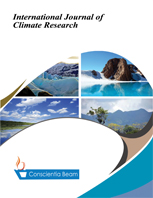An inclusive study of lightning at various temporal resolutions over North East India using hi-res satellite data
DOI:
https://doi.org/10.18488/112.v7i1.3543Abstract
Average lightning flash rate density (LFD) values for North East India (NEI) are analyzed for the 16-years (1998–2013) period based on high resolution TRMM LIS data. The number of lightning flash strokes are most active from March to October with the highest number of lightning strokes happening during the months of April and May, with the monsoon months witnessing the maximum spatial density shifting to the plains area. After October, LFD begin to decrease across the entire region. The highest LFD with a value of 56.65 flashes km-2 year-1, observed along an escarpment in the southern parts of Meghalaya plateau. The minimum is found in the semiarid high altitude districts along the Tibetan border in north with a value of 0.74 flashes km-2 year-1. We observed considerable Convective Available Potential Energy (CAPE) with moderately high LFD during the monsoon season, indicating the importance of these quantities in monsoon convections over this region. The low-level wind flow has a significant impact on the LFD distributions during the entire year. The Himalayas to the North and Bay of Bengal to the south enhance local convergence and convection resulting in lightning. Results of this study can be used in relation to lightning safety standards.

